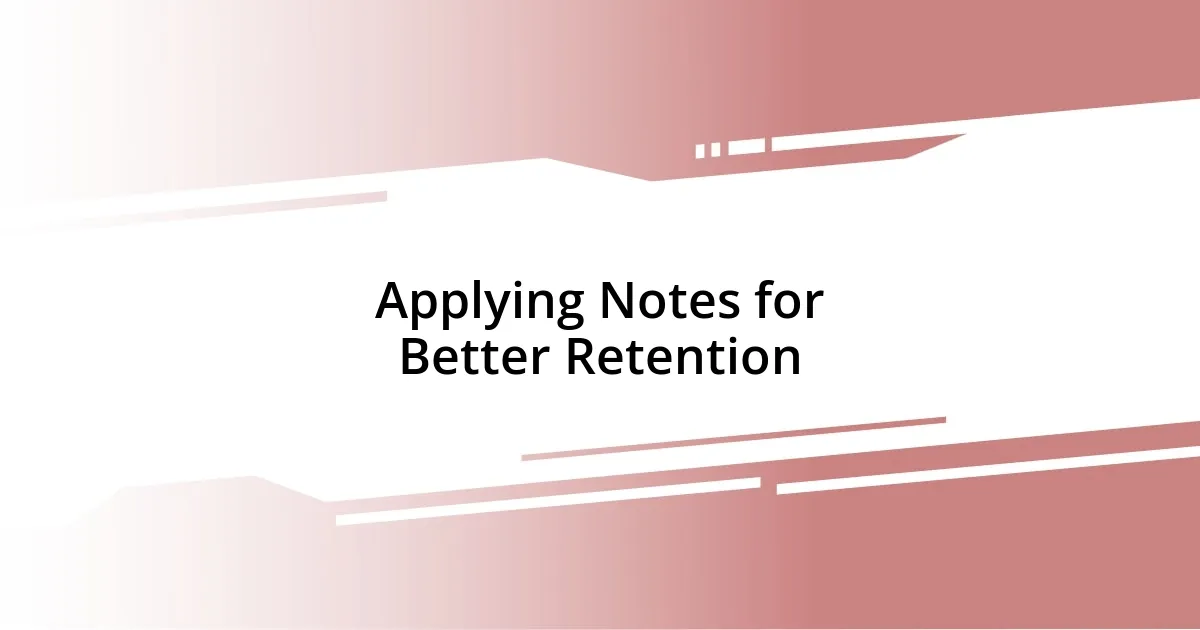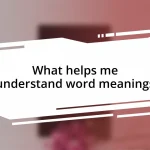Key takeaways:
- Effective note-taking enhances memory retention, comprehension, and confidence during discussions or exams.
- Identifying and experimenting with various note-taking styles (e.g., Cornell method, mind mapping) can deepen engagement with the material.
- Utilizing visual aids and organizing notes with headings, color-coding, and summaries improves clarity and retention of complex information.
- Regularly reviewing and revising notes, including active recall and spaced repetition techniques, solidifies understanding and reinforces memory.

Understanding the Importance of Note-Taking
Note-taking is more than just a method for recording information; it’s a powerful tool for enhancing memory retention and comprehension. I remember sitting in a lecture once, surrounded by classmates jotting down notes furiously, while I took my time to process the information. That pause allowed me to build connections in my mind, resulting in a deeper understanding of the material later on. Have you ever experienced that moment of clarity when reviewing your notes? It’s a moment I cherish, highlighting how effective note-taking can transform the learning experience.
Moreover, I’ve often found that my notes serve as a bridge between chaos and clarity. There’s something incredibly satisfying about looking back at my notes and finding organized thoughts and key concepts laid out before me. It feels like piecing together a puzzle, where each note adds to the complete picture of what I’ve learned. Have you thought about how your notes could act as a roadmap for your studies or future projects? They can guide your thought process and spark new ideas.
When I reflect on the times I didn’t take notes, it often leads to frustration. Trying to recall specific details without that physical record can feel like searching for a needle in a haystack. I realized that effective note-taking not only aids retention but also boosts confidence during discussions or exams. What if you could turn those moments of uncertainty into confidence by simply jotting down your thoughts? It’s an empowering shift that anyone can experience with a little practice and focus.

Identifying Your Note-Taking Style
Identifying your note-taking style is essential for maximizing your learning potential. I’ve experimented with various methods over the years, and each one revealed different aspects of my comprehension process. For instance, when I used the Cornell method, I found it forced me to summarize main ideas succinctly, which helped reinforce my understanding. Have you ever felt more connected to material when you rethink or rephrase it? That’s the beauty of discovering your unique style—it can deepen your engagement with the content.
I’ll never forget the time I decided to try mind mapping during a particularly dense subject. The visual layout allowed my thoughts to flow freely, connecting ideas I hadn’t realized were related. Suddenly, the lectures transformed from abstract concepts into a colorful canvas of knowledge. I encourage you to try different techniques until you find the one that feels natural. Exploring your preferences can unlock a new level of insight, propelling your learning journey forward.
It’s remarkable how personal experiences can shape our preferred note-taking methods. I once met a friend who swore by digital notes, using apps to organize her thoughts efficiently. Watching her effortlessly retrieve information inspired me to look for tech-based solutions myself. Have you considered that your environment or personality might influence your style? Understanding your inclinations will not only streamline your process but also enhance your enjoyment of learning.
| Note-Taking Style | Description |
|---|---|
| Cornell Method | Organizes notes into cues, main ideas, and summaries, fostering clarity. |
| Mind Mapping | Visualizes relationships between concepts, encouraging exploration and creativity. |
| Outline Method | Creates a hierarchical structure, perfect for structured and linear thinkers. |
| Digital Notes | Utilizes technology for flexibility, searchability, and easy organization. |

Choosing the Right Tools
### Choosing the Right Tools
Selecting the right tools can significantly enhance your note-taking experience. I remember purchasing my first set of colorful pens, hoping to make my notes visually appealing. It worked wonders! Not only did it make studying more enjoyable, but the different colors also helped me categorize information easily. I’ve found that the right tools can transform a mundane task into an inspiring one, adding a touch of creativity to the process.
When it comes to tools, here are some options to consider:
- Notebooks: Choose a size and style that feels comfortable. I prefer dotted pages for flexibility in drawing diagrams or writing notes.
- Digital apps: Applications like Notion or Evernote offer organization features that have kept me on track during intense study sessions.
- Highlighters: Using different colors allows for quick references and visual cues that help during revision.
- Voice recorders: Sometimes, verbal notes capture nuances in discussions that can be missed in written form. I often listen back to capture those ‘aha’ moments.
- Index cards: They’re great for breaking down complex topics into digestible pieces. I always keep some handy for quick reviews.
Finding what works best for you might take some experimentation, but the journey can be incredibly rewarding!

Organizing Your Notes Effectively
Organizing my notes effectively has made a significant difference in my retention and understanding of the material. I’ve often found that grouping similar ideas together creates a coherent narrative, which turns chaotic information into a well-structured story I can easily recall later. Have you ever noticed how much simpler it is to remember concepts when they’re linked logically?
One technique that I cherish is creating headings and subheadings within my notes. This method not only allows me to identify main ideas quickly, but it also breaks up the text visually, making it more inviting. I recall a particularly intense study session where I labeled each section clearly; it turned what could have been a frustrating scrabble for information into a smooth review process. Wouldn’t you agree that clarity can reduce stress during exam prep?
Another strategy I embraced is color-coding my notes—a delightful way to categorize themes or highlight critical points. I remember the first time I employed this technique; I almost felt like an artist organizing a palette. The colors reminded me of important concepts and made studying feel less like a chore and more like a creative endeavor. Have you tried using colors in your notes? You might find it transforms how you engage with the content!

Using Visual Aids for Clarity
Using visual aids in note-taking has been a game-changer for me. I vividly remember a class where the professor used diagrams and charts to explain complex theories. Those visuals helped me grasp the material instantly, turning abstract concepts into something tangible. Have you ever felt overwhelmed by text-heavy notes? Visual aids eliminate that chaos, providing clarity and engagement that words alone sometimes fail to offer.
One of my favorite techniques is incorporating mind maps into my notes. When I first tried it, I was skeptical about how a simple diagram could enhance my understanding. Yet, as I branched out ideas, connecting them visually, the information came alive for me. It’s amazing how mapping out thoughts can reveal relationships I may have otherwise overlooked. Doesn’t visualizing information make it easier to remember and connect the dots later?
Furthermore, I’ve delved into using infographics to summarize chapters or important topics. Initially, I thought it would take too much time, but I found that creating these visuals helped reinforce what I’d learned. The process was like storytelling with images, and it significantly deepened my comprehension of the material. Have you considered turning your notes into visuals? You might just discover a new, effective way to absorb the content!

Reviewing and Revising Your Notes
I’ve realized that reviewing and revising notes is just as crucial as taking them in the first place. After a lecture, I set aside time to go through my notes soon after; this helps reinforce what I’ve learned. It’s like giving my brain a little nudge to maintain that fresh connection to the material. Have you ever felt that sense of accomplishment when you review your notes and find connections you initially missed?
During my revision sessions, I often find it helpful to read aloud. There’s something about hearing the material that enhances my understanding and retention. I distinctly remember a moment when I was revising for a big exam, and I stumbled upon a mistake in my notes. Correcting that error not only clarified my understanding but also built my confidence. Isn’t it rewarding to discover and rectify misunderstandings before a test?
Additionally, I take the time to summarize my notes in my own words after reviewing them. This practice not only solidifies my grasp of the subject but also allows me to express the ideas in a way that feels authentic to me. Whenever I do this, I feel like I’m crafting a personalized narrative of my learning experience. Do you think putting concepts into your own words might create a stronger memory? I truly believe it helps transform the material into something you own, making the information more accessible down the line.

Applying Notes for Better Retention
After I take my initial notes, I often apply a technique that has really helped me retain information: active recall. I use the notes as prompts, turning them into questions. For instance, if I cover a topic in class, I’ll jot down questions like, “What are the key principles?” or “How does this concept relate to what I studied before?” It’s a fascinating process that makes me feel more engaged with the material. Have you tried transforming your notes into questions? It can truly turn passive reviewing into an active and dynamic learning experience.
Another method I embrace is the spaced repetition technique. I’ve noticed that revisiting notes after increasing intervals—like a day later, then a week later, and so on—really solidifies my memory. I remember cramming for exams in college and realizing I’d forget things shortly after. By spacing out my review sessions and integrating my notes into my daily routine, I started to see a remarkable difference in what I retained. It felt empowering to watch my understanding deepen over time. Have you found that consistency in reviewing helps you remember better?
In addition, I love discussing my notes with peers. Explaining concepts to someone else not only reinforces my own understanding but often sparks new insights. I recall preparing for a group project, and while sharing my notes, I stumbled upon a connection I’d missed entirely. It was like a light bulb moment, where discussing things opened up a whole new layer of understanding. Have you ever experienced that thrill of discovering something new while teaching someone else? It’s those moments that transform learning from a solitary task into a collaborative adventure!













